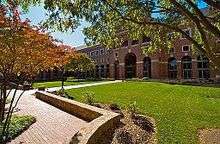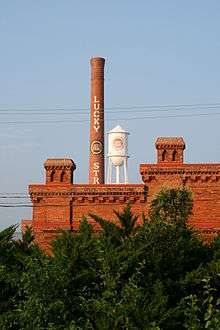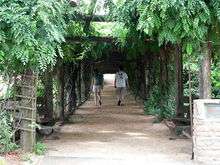Research Triangle
Sprawling in the heart of North Carolina's Piedmont, the Research Triangle is a metro area of about two million people. Largely suburban in nature, the Triangle is unique for a metro area in that, rather than having one primary city at its center, the region's focus is split between three cities: Raleigh, the state capital; Durham, a former industrial center; and Chapel Hill, a prominent college town.

The region derives its name from the major research universities in each of the Triangle's three cities as well as the vast office park that sits between these cities and is home to many research and high tech firms. These industries have spurred the rapid economic growth of the region. Visitors will find scenic college campuses, many of the state's cultural institutions, and a diverse population drawn by the Triangle's academic institutions and relatively high standard of living.
Cities
The main three cities that make up the "Triangle" are:
- 🌍 Chapel Hill - A lovely college town based around the University of North Carolina, with college basketball, live music venues, and a beautiful campus with colonial-style brick buildings.
- 🌍 Durham - Once the center of tobacco country, now home to the Gothic-style architecture of Duke University, a vibrant arts scene, and a revitalizing downtown district.
- 🌍 Raleigh - The state capital, home to many of the state's cultural institutions, including three state museums, the state's performing arts center, and North Carolina State University.
In addition, there are a few towns in the area that have become suburbs of the metro area:
- 🌍 Apex - An expanding suburb near the Research Triangle Park.
- 🌍 Cary - A sprawling, fast-growing suburb west of Raleigh.
- 🌍 Fuquay-Varina - A town south of Raleigh, now a growing suburb.
- 🌍 Hillsborough - A historic settlement west of Durham that's home to arts and music festivals.
- 🌍 Pittsboro - Historic town with a sanctuary for tigers and other big cats.
- 🌍 Wake Forest - Historic town that served as the original home of Wake Forest University and is the current home of the Southeastern Baptist Theological Seminary.
Several other small towns are further afield but still part of the broader region surrounding the Triangle:
Understand

The Research Triangle, also known to the locals as the Triangle, is a region consisting of 3 anchor cities, Raleigh, Durham, and Chapel Hill, and everything in between. The name, "Triangle" was originally coined to refer to the three universities, North Carolina State University, Duke University, and the University of North Carolina, all fierce rivals. One of the largest research parks in the world, Research Triangle Park is located in the area, and has attracted both large companies and high numbers of immigrants from other parts of the United States, as well as all over the world. Leading employers such as IBM, Cisco Systems, SAS Institute, GlaxoSmithKline, and Biogen have ensured the exceptional performance of the strong economy. Both the universities and the research park are factors in the fact that the region is one of the most diverse in North Carolina.
Climate
This part of North Carolina can be hot and muggy during the summers (but air conditioning is widespread). Winters are relatively mild, and spring and autumn are popular for their pleasant weather.
| Research Triangle | ||||||||||||||||||||||||||||||||||||||||||||||||||||||||||||
|---|---|---|---|---|---|---|---|---|---|---|---|---|---|---|---|---|---|---|---|---|---|---|---|---|---|---|---|---|---|---|---|---|---|---|---|---|---|---|---|---|---|---|---|---|---|---|---|---|---|---|---|---|---|---|---|---|---|---|---|---|
| Climate chart (explanation) | ||||||||||||||||||||||||||||||||||||||||||||||||||||||||||||
| ||||||||||||||||||||||||||||||||||||||||||||||||||||||||||||
| ||||||||||||||||||||||||||||||||||||||||||||||||||||||||||||
Get in

By plane
Raleigh-Durham International Airport (RDU IATA) is the main airport for the region, located at the center of the metro area near the Research Triangle Park, just off I-40. A former hub of American Airlines and Midway Airlines, the airport today is one of the larger national airports without official hub status - some 9 million passengers embark and deplane annually, making it one of the nation's fastest-growing airports. American's strong continued presence here gives RDU daily direct service to London Heathrow, and Delta's recent growth in Raleigh is shown by the direct flight to Paris. A broad span of carriers (both traditional and low-cost) offer flights to most East Coast cities, and an increasing number of Western cities including Las Vegas, Phoenix, San Francisco, Los Angeles and Denver. Air Canada offers several flights per day to Toronto.
RDU has two terminals; Southwest is the sole airline in the older Terminal 1, while the more modern and architecturally impressive Terminal 2 services the legacy carriers Alaska, American Airlines, Delta, and United, as well as the low-cost airlines Jetblue, Frontier, and Allegiant. A large rental car facility is located on-site. Public transit bus service is offered by Triangle Transit route #100, which runs between Raleigh and a transit center near the Research Triangle Park. Free WiFi is provided by Boingo—it's unlimited, but you have to look at an ad every 45 minutes.
By car
- Interstate 40 cuts east-west through the Triangle, passing through Raleigh and the Research Triangle Park and along the outskirts of Durham and Chapel Hill, continuing west to Greensboro, Winston-Salem, and Asheville, and east to Wilmington.
- Interstates 85 and 95 run north-south through the area, providing easy access to the region from up and down the Eastern Seaboard. I-85 passes through Durham, continuing north to Petersburg, Virginia (where it terminates at I-95) and west, merging with I-40 to Greensboro before splitting off to Charlotte. I-95 doesn't serve the Triangle directly, but rather skirts the eastern edge of it, where you can take I-40, US-64, US-70, or US-264 into the Triangle.
- US-1, the East Coast corridor route, cuts through Raleigh on its way from New York to the Florida Keys.
By train
Amtrak serves the Triangle with three routes: the Piedmont runs twice-daily to Charlotte, a trip of just over three hours, serving Raleigh, Cary, and Durham. The Carolinian runs once a day between Charlotte and the Eastern Seaboard, serving the same stops as the Piedmont, while the once-daily Silver Star stops in Cary and Raleigh on its way between New York City and Florida.
By bus
There are two intercity bus carriers serving the Triangle: Greyhound serves depots in Raleigh and Durham, while Megabus has a stop in Durham on its Charlotte-Washington, D.C. route. The regional bus system PART (Piedmont Authority for Regional Transit) has one line to Chapel Hill from the Piedmont Triad.
Get around

Given the very spread-out and suburban nature of the Triangle, driving is easily the most convenient way to get around. Interstate 40 is the main east-west corridor that links up the main cities of the Triangle, passing through Raleigh, the Research Triangle Park, and past RDU airport and Chapel Hill. The Durham Freeway (NC 147) links the Research Triangle Park and I-40 to Durham, while US-15/501 connects Durham to Chapel Hill. The Triangle Expressway, North Carolina's first modern toll road, follows NC 147 from I-40 to I-540, then NC 540 to Apex and Holly Springs. There are also two loop freeways circling Raleigh and serving many of the suburbs: I-440 circles the central portion of Raleigh proper, while I-540 traverses much of the suburban fringe north of Raleigh before heading south to the Research Triangle Park. South of the RTP, I-540 becomes a state-run toll freeway for the stretch around Cary south to Apex.
Each of the main cities operates a local bus service. Regional service is provided by Go Triangle, which operates all-day service Monday-Sunday (no service during certain holidays) between Raleigh, Durham, and Chapel Hill, operating out of a hub (the Regional Transit Center, RTC) near the Research Triangle Park. Fares cost $2.25 per trip, with $4.50 for a day pass.
See

The universities! They're what the region is known for: Chapel Hill has UNC, Durham has Duke, and Raleigh has NC State (as well as several other lesser-known schools). All three have attractive campuses that include historic buildings. Naturally, they also include various other sights within their ecosystems, from varied museums to extensive botanical gardens and arboretums at all three universities.
The area also has its share of historic districts and the like. Especially worth noting are several antebellum and Civil War sites in Durham, Hillsborough's walkable downtown, and Raleigh's State Capitol building.
Do
With the many universities in the area, it should come as no surprise that college sports are a big deal here. The Duke Blue Devils, the North Carolina Tar Heels, and (to a lesser extent) the NC State Wolfpack all have fiercely loyal fan bases, with immensely popular football and basketball programs. The Carolina-Duke rivalry is particularly fierce, with two of the most well-regarded basketball programs in the country. Non-college sports teams in the area include the popular Durham Bulls minor league baseball team and Raleigh's Carolina Hurricanes NHL hockey team.
There are many excellent performing arts spaces in the Triangle, hosting a lively theater scene. The lion's share of these are located in Durham, which is home to the prominent Durham Performing Arts Center, the historic Carolina Theatre, and a number of small, independent local theaters. Downtown Raleigh is home to the state-run Duke Energy Center for the Performing Arts, which plays host to the state ballet, opera, and symphony.
And if you're looking to get away from the towns for some outdoor activities, the Triangle and its surrounding rural areas have state parks and nature. Particularly worth a visit are Eno River State Park near Durham, Umstead State Park in Raleigh, Raven Rock State Park near Fuquay-Varina, and Jordan Lake to the southwest of the metro area.
Eat
Durham is without a doubt the area's top destination for foodies, but Raleigh and Chapel Hill have more than their share of quality restaurants as well. For visitors who want to sample traditional local cuisine, restaurants serving authentic North Carolina cooking can be found in all three of the Triangle's main cities.
Drink
Out of the three cities, Chapel Hill is considered to have the best bars, due to the abundance of students in the area. Durham and Raleigh also have a fair share of drinking establishments, mainly centered around the universities.
Go next
- Charlotte Metro – centered around Charlotte, the biggest city in North Carolina, a bustling, rapidly growing economic powerhouse (not unlike the Triangle)
- Piedmont Triad – an urban area nearby that's also centered around three main cities
- Wilmington – the beach!